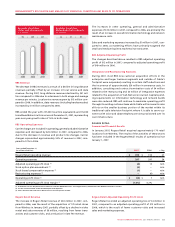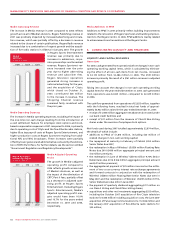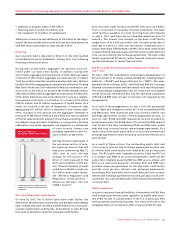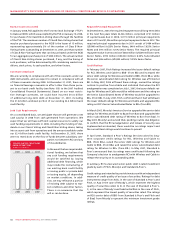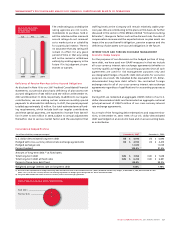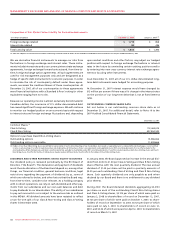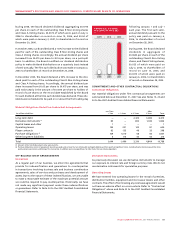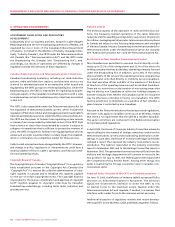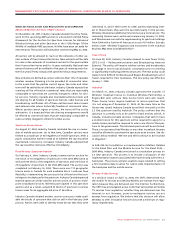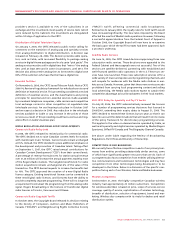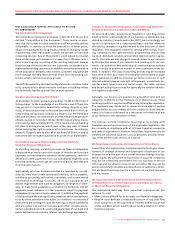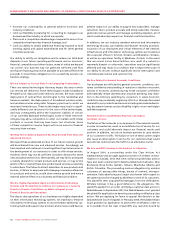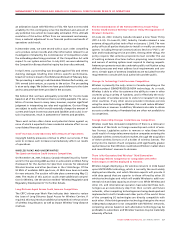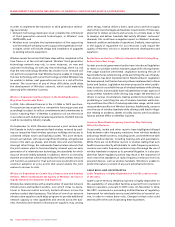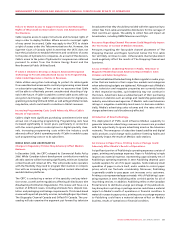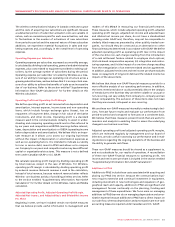Rogers 2007 Annual Report Download - page 55
Download and view the complete annual report
Please find page 55 of the 2007 Rogers annual report below. You can navigate through the pages in the report by either clicking on the pages listed below, or by using the keyword search tool below to find specific information within the annual report.
ROGERS COMMUNICATIONS INC. 2007 ANNUAL REPORT 51
MANAGEMENT’S DISCUSSION AND ANALYSIS OF FINANCIAL CONDITION AND RESULTS OF OPERATIONS
WIRELESS REGULATION AND REGUL ATORY DEVELOPMENTS
Advanced Wireless Services (“AWS”) Auction
On November 28, 2007, Industry Canada released its policy frame-
work for the upcoming AWS auction in a document entitled Policy
Framework for the Auction for Spectrum Licences for Advanced
Wireless Services and other Spectrum in the 2 GHz Range. Of the
90 MHz of available AWS spectrum, 40 MHz have been set aside for
new entrants. The auction will take place commencing May 27, 2008.
All carriers will be allowed to roam on the networks of other car-
riers outside of their licenced territories. New entrants will be able
to roam on the networks of incumbent carriers for five years within
their licenced territories and for 10 years nationally. National new
entrant licencees will be entitled to five years of roaming and a fur-
ther five years if they comply with specified rollout requirements.
New entrants are defined as carriers with less than 10% of Canada’s
wireless revenue. Roaming is to be provided at commercial rates.
In the event that the parties cannot agree, the rates and other
terms will be settled by an arbitrator. Industry Canada expects that
roaming will be offered at commercial rates that are reasonably
comparable to rates that are currently charged to others for simi-
lar services. Industry Canada also mandated antenna tower and
site sharing for all holders of spectrum licences, radio licences and
broadcasting certificates. All of these entities must share towers
and antenna sites where technically feasible at commercial rates.
Where parties cannot agree on terms, the terms will be set by
arbitration. It is expected that site-sharing arrangements would
be offered at commercial rates that are reasonably comparable to
rates currently charged to others for similar access.
Spectrum Licence Issues
On August 27, 2004, Industry Canada rescinded the cap on owner-
ship of mobile spectrum. Up to that time, Canadian carriers were
limited to a maximum of 55 megahertz of mobile spectrum. After a
public consultation earlier in 2004 as to whether the cap should be
maintained, removed or increased, Industry Canada advised that
the cap would be removed, effective immediately.
Fixed Wireless Spectrum Auction
On February 9, 2004, Industry Canada commenced an auction for
one block of 30 megahertz of spectrum in the 2300 MHz band as
well as three blocks of 50 megahertz of spectrum and one block of
25 megahertz of spectrum in the 3500 MHz band. The auction was
completed on February 16, 2004. There were over 172 geographic
licence areas in Canada for each available block. Licencees have
flexibility in determining the services to be offered and the tech-
nologies to be deployed in the spectrum. Industry Canada expected
that the spectrum will be used for point-to-point or point-to-multi-
point broadband services. Wireless participated in this spectrum
auction and, as a result, acquired 33 blocks of spectrum in various
licence areas for an aggregate bid price of $6 million.
Industry Canada initiated another auction process to make avail-
able the blocks of spectrum that did not sell in the February 2004
process. Parties were able to identify those blocks that they were
interested in, and if there were no other parties expressing inter-
est in those blocks, they were the successful party. In this process,
Wireless obtained an additional nine licences at a nominal cost. The
remaining licences were auctioned commencing January 10, 2005,
and Wireless was successful in supplementing its spectrum holdings
from 2004 with a further 40 licences at a cost of $5 million. See also
below under “Wireless’ Expansion and Investment in the Inukshuk
Business May Have Considerable Risks”.
Tower Policy
On June 28, 2007, Industry Canada released its new Tower Policy
(CPC-2-0-03 – Radiocommunication and Broadcasting Antenna
Systems). The policy will require wireless carriers and broadcasters
to engage in more local and public consultation prior to erecting
or significantly modifying antenna structures. The new policy could
make it more difficult for Wireless and Rogers Broadcasting to erect
towers required for their businesses. The new policy was effective
January 1, 2008.
Inukshuk
On March 31, 2006, Industry Canada approved the transfer of
Wireless’ Inukshuk licence to Inukshuk Wireless Partnership, a
Rogers-Bell joint venture. New licence terms were also issued.
These licence terms require Inukshuk to return spectrum that
it is not using as of December 31, 2009. At the same time as the
licence was issued, Industry Canada issued their new policy on the
2.5 GHz spectrum used by Inukshuk. The policy confirms that the
spectrum is currently only to be used for fixed services (which, in
Canada, includes portable services). Companies that wish to have
a mobile licence for this spectrum will be required to apply for a
mobile licence and will be required to return one-third of the spec-
trum to the government. The returned spectrum will be auctioned.
There is no assurance that Wireless or any other incumbent licencee
would be allowed to purchase the spectrum at an auction. See dis-
cussion below entitled “We Are and Will Continue to Be Involved
in Litigation”.
In SAB-002-06 Consultation on Implementation Matters Related
to the Band Plan and the Mobile Service for the Band 2500 –
2690 MHz, Industry Canada announced a consultation process on
2.5 GHz spectrum. This process is to include a discussion of the
implementation matters associated with harmonizing with the U.S.
band plan. The process will also examine issues related to setting
a firm transition date to allow for nation-wide implementation of
the band plan and the mobile service.
Wireless Video Services
In a decision issued on April 12, 2006, the CRTC determined that
the mobile TV services provided by Wireless are exempt from regu-
lation because they are delivered over the Internet. Furthermore,
the CRTC has promulgated a new order that will exempt all mobile
TV services from regulation, whether they are delivered over the
Internet or not. However, point-to-multipoint services are not
exempt from regulation. We believe that this decision will allow
Wireless to offer innovative new services with a minimum of regu-
latory impediments.


